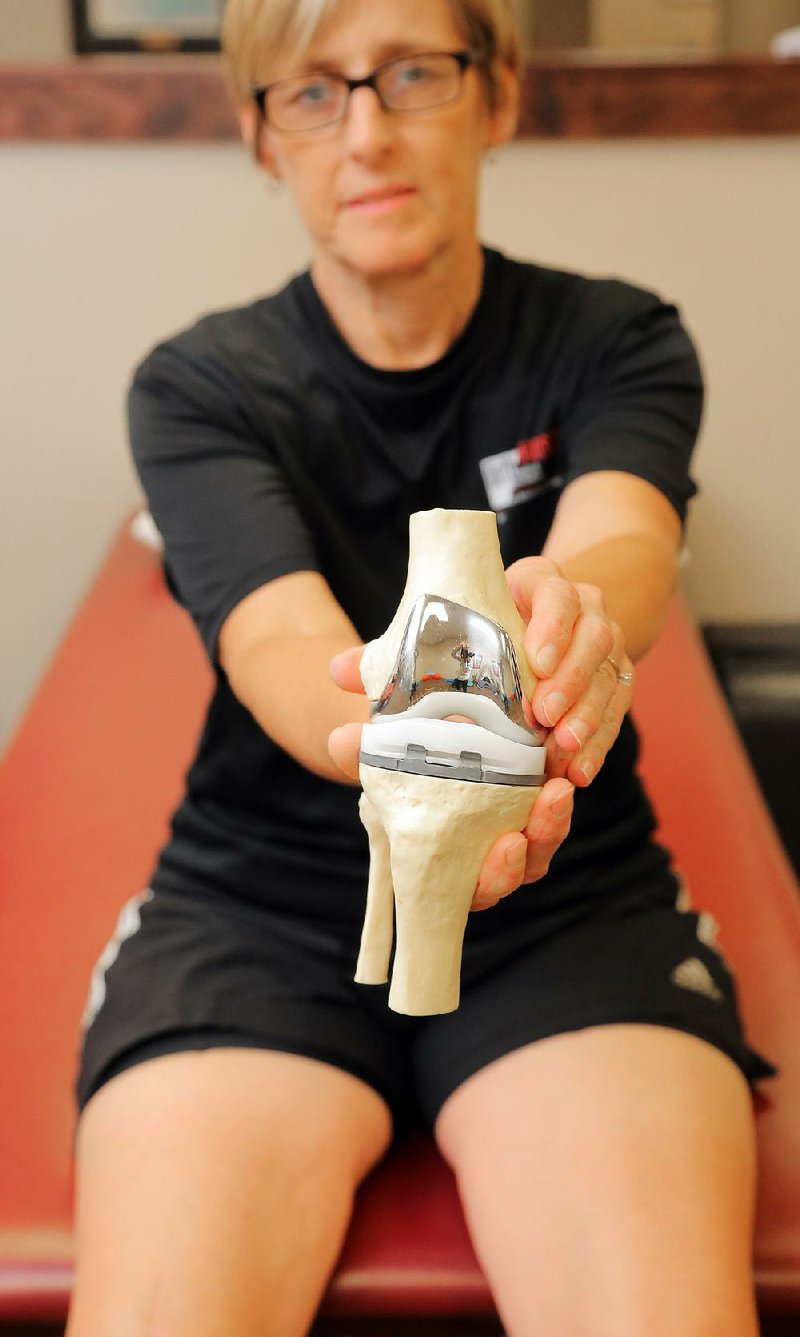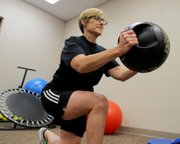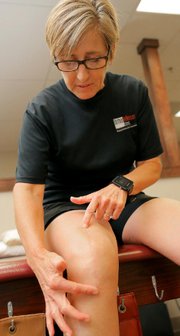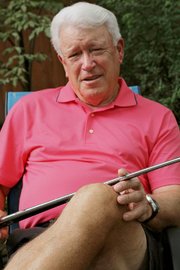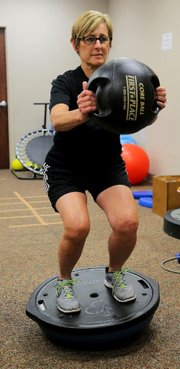Credit Tom Butler's knees -- both replaced -- to baseball.
"I've coached Little League for 49 years," said the 72-year-old resident of Little Rock. "I've thrown a lot of batting practice and hit a lot of grounders."
Think of the wear and tear, he said, pushing and landing on the left knee, pitching batting practice, hour after hour, 49 years' worth.
On the other, um, knee, "I've never grown up. I still get to play ball."
His knee replacement story is a happy one. Barbara Mullins' knee replacement story, not so much. If she knew then what she knows now ....
Butler and Mullins are two sides of a big coin. Knee replacements are serious medical business.
• The Centers for Disease Control and Prevention's National Center for Health Statistics reports that from 2000 to 2010, an estimated 5.2 million total knee replacements were done. Adults 45 and over comprised 98.1 percent of those surgeries.
• The rate of total knee replacements in that time period went up 86 percent for men and 99 percent for women.
• A 2014 report by the American Joint Replacement Registry showed the mean age of patients having a knee replacement was 66.1 years. And that osteoarthritis was the underlying or original diagnosis for nearly 95 percent of the cases.
• Medicare is experimenting with how it pays for knee, and hip, replacements in an effort to improve quality and lower costs by heading off postsurgical complications. A new system of following patients more closely during their recovery covers hospitals in 67 metro areas, including Garland and Crittenden counties in Arkansas. Medicare says it paid for more than 400,000 knee and hip replacements in 2014, at a cost to the taxpayer of $7 billion.
• A 2015 study by Blue Cross and Blue Shield examined three years of claims data to determine cost variations for knee and hip replacements in 64 markets around the country, including Northwest Arkansas. It found the average typical cost for a total knee replacement was lowest at $11,317 in Montgomery, Ala., and highest at $69,654 in New York.
In Fayetteville-Springdale, the average cost was $26,129.04, with a low of $23,365.93 and a high of $27,698.10. The highest variation found in a single market was in Dallas, where the cost of a knee replacement ranged from $16,772 to $61,585.
Enough data. Let's talk about people.
REHAB'S NOT A SNAP
Butler retired in 2014 from the University of Arkansas for Medical Sciences as vice chancellor for administration and governmental relations.
He had his left knee replaced while working at UAMS, and a subsequent part replacement of that knee after a skiing trip to Banff, Alberta. Right about the time he retired, "I think my right knee just went."
Eight weeks and two days after the right knee was replaced, he said, he played golf.
How did he know when to have his knees examined?
"When you start getting up two or three times a night with your knee, you know it's time. It's not a killer pain, but it's irritating."
After the first replacement, Butler did his rehabilitation at home.
"Totally useless," he said. "Everything went wrong."
His second rehab, after the right knee was replaced, was done at a physical therapist's office. Rehab, he said, is the hardest part.
"It hurts. I don't care what anybody says. The time between the second and fifth weeks are just miserable. If you get your thighs built up before surgery it works better for you.
"Every day, you have to stay after it. In your mind you say, 'If I move this thing it's gonna hurt.' It's that reluctance. As far as I was concerned, I pushed it as much as I could."
Listen to the physical therapist, Butler said.
"Don't think you know more. You've got to be religious about it. Suck it up, get down and do it."
It's a little weird having something in your body that's not original.
"I know this is not my knee, but it doesn't hurt," Butler said. "I can climb Pinnacle if I want to."
A MISTAKE
Barbara Mullins is 73 and lives in North Little Rock with her husband, Gene. He was about to have a knee replacement a few years ago, but didn't. He said that worked out fine. Barbara, conversely, did something extraordinary.
She had both knees replaced. A day apart.
This happened at UAMS, back in 2007. The right knee was first. Her doctor, Mullins said, told her the left knee would need a replacement in a couple of years anyway, so it would be convenient to do both. That doctor has left UAMS, she said.
"I'd never had major surgery," Mullins said. "I figured I would be back to normal in six weeks."
When she went to rehab, the actual experience was the opposite.
"They said I was nuts for doing both knees at once. The physical therapist said she'd never had someone who had both knees done at the same time."
Mullins puttered along for a while. She did OK. Then one year she was tossing out the Christmas tree.
"The little pad between the metal parts of the knee shifted."
Back to UAMS, where Dr. Lowry Barnes said she needed either a revision or a new replacement, and she'd know which one when she woke up from surgery. Barnes was her second opinion. She decided on a third, at Mayo Clinic in Minnesota.
"We flew up, stayed in a hotel, the whole thing," Mullins said. "The doctor there said to do whatever Lowry Barnes said to do. They were friends."
Mullins went back to UAMS. Barnes put in a bigger pad, she said, and then it was on to rehab and a personal trainer who worked out an individual program of exercise to strengthen Mullins' leg muscles and improve her flexibility.
Now, about five years later, Mullins is "very careful."
"If I'm on an uneven surface, I use a cane because my eyesight isn't so good."
Hindsight tells Mullins she shouldn't have agreed to having both knees replaced. "Only the knee that really needed it," she said. "Because the other one is the one that gives me trouble. And it was not the primary problem.
"But it seemed like a good idea at the time."
Her advice: Get a second or third opinion. Keep up the rehab.
Mullins' recovery from the pad replacement took about a year.
"I told myself that by the time of the next Christmas service, I would be able to kneel at the altar."
She did.
"But I couldn't have done it by Easter."
DAILY DISABILITIES
Knee replacement is the end-stage treatment for arthritis, which is so prevalent. Why? People are living longer and doing more damage to the joint. Barnes calls it "baby boomer knee."
"And we have a demand society," Barnes said. "We want to be able to function. We don't like pain."
"Patients want to stay mobile and active," he said. "They can't do that if they have a severely worn-out knee."
Who should have a knee replacement?
People who have pain on a daily basis. Or who can't get up out of a chair. Or who can't sleep for the pain. "They can't do things with their grandkids. They can't go up and down bleachers to watch their sports teams."
Barnes said he does 400 knee replacements a year, along with 300 hip replacements.
"Hospitals and surgeons who do more knee replacements have lower complications. Arkansas is fortunate to have a number of surgeons who do a lot."
On the other hand, he said, research shows that 80 percent of total knee replacements are done by surgeons who do fewer than 20 a year.
After 30 years, Barnes estimates, he has done 8,000 to 10,000 knee replacements. Used to be, he said, a knee replacement meant 12 days of recovery. Now patients are up the next day. Pain is better controlled, too, with local injections to block the pain for the first few days.
"At the end of the day," Barnes said, "every surgery depends on the art of balancing the knee so the tendons are properly positioned. Regardless of the implant, it's still how the tissues are balanced."
There are alternatives to surgery, such as exercise, to strengthen the muscles that support the knee. Anti-inflammatory drugs, over-the-counter and prescription, could help. And there's weight loss.
"Losing 25 pounds is like losing 100 pounds," Barnes said. He won't do surgery on people whose body mass index is over 40.
Bad news. Arkansas has one of the nation's highest obesity rates, with about 35 percent of adults judged obese, according to the CDC.
Post-operation, patients go through rehab. After which, common sense.
Barnes recommends against running but has patients who have returned to tennis and golf. One is back to playing racquetball. Biking is great. Swimming is great.
The risk of high-stress activities, he said, is that they may reduce the life of the implant, "but there's no good data to prove that."
One of Barnes' most recognizable patients is Terry Bradshaw, the former professional quarterback, current TV personality and notoriously funny man. Bradshaw spoke to the UA Board of Trustees in January about his knee surgery. Bradshaw told the board he met with Barnes on a Monday, had his right knee replaced on Tuesday and was back in action in short order.
Barnes said Bradshaw was referred to UAMS by Dr. James Andrews of Birmingham, Ala., a renowned sports orthopedic surgeon.
"We expected a tough rehab, but it went amazingly well," Barnes said. "He had the surgery on Tuesday and on Friday he had a party in Los Angeles for Fox. He was on the air five days after surgery."
Barnes is 55. How are his baby boomer knees?
"They're good. I wear ugly shoes with nice support soles."
Is that advice?
"Not the ugly part. But Vibram soles take a lot of the stress off."
EXPECT DISCOMFORT
Barbara Tucker-Ketchum works where the Vibram meets the road. She's a physical therapist at OrthoArkansas in Little Rock, and had her own right knee replaced in November 2015.
Physical therapy is Ketchum's second career. She was a high-school teacher and coach. Her knee gave out after years of softball, tennis and racquetball and two surgeries to fix a torn meniscus. She enjoys cycling.
"It wasn't so much the pain," she said, "as it was limiting my function. At my age [57], I didn't want to be limited in what I do. I already gave up softball. I couldn't give up cycling."
Her surgery was on a Wednesday, she went home Thursday and was in therapy Friday. She managed the pain with ice pads; the opioid Tramadol; and transcutaneous electrical nerve stimulation delivered by a TENS unit, a small, battery-powered device that uses mild electrical signals to control pain.
Ketchum acknowledges that physical therapy on a knee can be painful, but it's not as bad as people expect. So keep working. "If you wait until it quits hurting, it will never quit hurting."
Therapy can last three to four weeks after surgery, she said, and patients should keep working on their own for up to six months, and it often takes a year for the knee to feel comfortable. Goals are full extension and a good gait pattern. A bad gait "will throw out the hip and back, because our body is a chain."
That first year will be a roller coaster, Ketchum warned. The knee will hurt, and feel good, hurt, and feel good. "Don't be alarmed. This will happen."
Smart things to do after surgery include cycling, swimming and walking within reason, moderately, while avoiding hills. And lose weight. "For every pound you lose you take 4 pounds of stress off your knee."
Dumb things? Stop exercising. "A very dumb thing is to not continue exercising at least three times a week."
Another dumb thing is to do too much too soon. Ketchum, three months after surgery, hiked three weekends in a row, resulting in a steroid shot.
Knowing what she knows, would Ketchum have a knee replacement again?
"Absolutely," she said, and added that she's up to 27 miles of cycling at a time. "I didn't have this done to sit on the couch."
ActiveStyle on 06/13/2016
